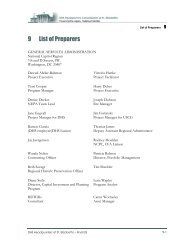395 - GSA Development of St. Elizabeths Campus
395 - GSA Development of St. Elizabeths Campus
395 - GSA Development of St. Elizabeths Campus
- No tags were found...
Create successful ePaper yourself
Turn your PDF publications into a flip-book with our unique Google optimized e-Paper software.
travelling westbound (in morning peak period) and eastbound (in afternoonpeak period). East <strong>of</strong> this intersection, Suitland Parkway abruptly transitionsfrom an urban-style arterial to a high-speed controlled access facility thatstretches into suburban Maryland and links with the major arterial MarylandRoute 4, which makes this intersection a “choke point” for traffic flow duringpeak periods.• Martin Luther King Jr. Avenue is generally congested for several reasons. Thissecondary arterial is the only continuous north-south local route that spans the entire<strong>St</strong>udy Area. The facility also connects Anacostia with the Southeast-Southwest Freeway(I-695) via the 11 th <strong>St</strong>reet Bridges, and carries a disproportionate amount <strong>of</strong> cut-throughtraffic due to missing connections at the 11 th <strong>St</strong>reet Bridges/Anacostia Freeway andelsewhere along I-295/DC 295. The five-legged intersection at Howard Road is acongestion focal point for many <strong>of</strong> the same reasons as the operations at SuitlandParkway/Firth <strong>St</strong>erling intersection.• The interchange <strong>of</strong> Alabama Avenue at Suitland Parkway is frequently congested alongthe west half <strong>of</strong> the ramp terminal interfaces because <strong>of</strong> the frequency and close spacing<strong>of</strong> traffic signals along Alabama Avenue. The high incidence <strong>of</strong> pedestrian trafficrequires this area to be controlled by DDOT traffic control <strong>of</strong>ficers during peak periods,especially at the beginning and ending <strong>of</strong> the school day.• The interchange <strong>of</strong> Malcolm X Avenue at South Capitol <strong>St</strong>reet is congested due to theconfiguration <strong>of</strong> the two closely-spaced intersections at the ramp terminals, which arenot optimally phased or channelized to accommodate existing traffic demand. Theconcentration <strong>of</strong> inbound and outbound trips at the main gated entrance to Bolling AirForce Base also contributes to congestion. The adjacent interchange <strong>of</strong> Malcolm XAvenue and I-295 operates as complementary access point for northbound I-295 trafficin combination with the South Capitol <strong>St</strong>reet interchange. On I-295 northbound,weaving traffic between the two loop ramps exceeds the volume capacity <strong>of</strong> thisinterchange, resulting in queues along I-295 northbound and Malcolm X Avenueeastbound.• General north-south traffic along principal routes is impacted by downstreambottlenecks and congestion on both ends <strong>of</strong> the <strong>St</strong>udy Area. The configuration <strong>of</strong> the 11 th<strong>St</strong>reet Bridges interchange and the Suitland Parkway / South Capitol <strong>St</strong>reet interchangecontribute to system-wide queuing. Downstream congestion on other roadways alsocauses spillback that reflects back through the arterials within the network.2.2.3 DeficienciesAs referenced above, several locations within the <strong>St</strong>udy Area have significant operationaldeficiencies that contribute to congested conditions. Other locations reflect substandardroadway or intersection designs that pose safety risks and/or adversely affect the accessibility<strong>of</strong> local roadways. Transportation network design deficiencies in the <strong>St</strong>udy Area include:• Missing ramp connections between local Anacostia roadways and the AnacostiaFreeway at the interchange with 11 th <strong>St</strong>reet Bridges2-4
















